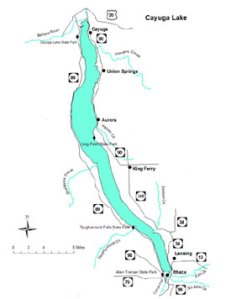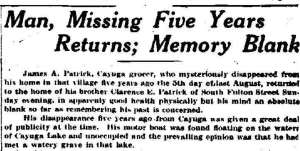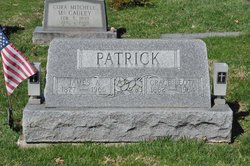A Note to My Readers: Trolleys are one of my all-time favorite things. I lived in the San Francisco bay area for a couple of years and loved hopping onto those beauties. I am also a train geek…passed that on to my grandson. As a kid growing up in Auburn, New York, I only vaguely became aware of trolleys when winter thaw would lift the weakened macadam from the underlying cobblestone on Genesee Street and the iron rails would be exposed. My mother, who grew up in Ithaca, would often tell me about riding the trolleys as a child and what a thrill that was for her. It wasn’t a typical thing for the Purdys to do, but an event where everyone wore their best attire, including hats and gloves.
My grandmother would tuck peppermints in her purse and once they were seated, she would dole them out to keep the children still. There is something tender about that bit of nostalgia and I suppose that is why the romance of riding a trolley has stuck with me. When my father died in 1958, mom sold the car and our transportation modes were city bus and good old ‘bus number two’. Those were the days when not everyone had a car and those that did had just one. The family car. Fathers drove it to work and to church and took the family on those wonderful Sunday drives in the countryside.
I didn’t drive until I was 24 years old and a young mother. My mother said I was a pioneer. Really!
She always carried peppermints in her purse and I suspect if Auburn still had trolleys when I was growing up, she would have definitely preferred to hop on and let the buses go on without her.
HIRAM MIAL TITUS
Hiram Mial Titus (1861-1943) is my first cousin 3X removed. We are both descendants of Gilbert Titus and Jane Hoag who along with their son David Sands Titus and his family and their daughter Lydia H. Titus Downing and her family arrived in the village of Cayuga in 1829. Hiram is descended from David and I am descended from Lydia. Lydia is my mother’s great great grandmother. I have put together a scholastic publication for this branch of the family tree and it will be published later this year.
While it has been a great journey studying my Quaker family history, it has also been fascinating to learn about the generations beyond David and Lydia.
David’s son Hiram inherited a substantial part of the Titus land in Cayuga and by 1879 had an impressive operation with prize -winning cattle and horses. Though he indulged in a team of “handsome” matching black horses for his sleigh and drove the team into Auburn, New York often to show off his magnificent animals, he also loved the ‘new-fangled’. He was an old man of eighty-four in 1912 when he was photographed with his wife, Ada B. Shoemaker Titus and his prized Indian motorized bicycle.
Despite all of Hiram’s successes at farming and his social and political prominence in Aurelius, his sons did not share his passion for the bucolic life along the shores of Cayuga Lake. In 1895 thirty-four year-old Hiram, Jr. sold his meat market and left the small village of Cayuga to go to the bustling and expanding city of Auburn, New York to ride the rails.
As one of the first men to be employed by the Auburn & Syracuse Electric Railway(then the Auburn Inter-Urban Electric Railroad), he helped survey the line on which he later became a conductor. During that time, Hiram served as superintendent of the old Lakeside Park at the foot of Owasco Lake for over fifteen years when the park was operated by the railway. A park that was part of my summer every day of my young life in the 1950’s and 60’s and where my 50th class reunion will be held this year.
No. 63 was full to capacity that day and many took the ride as a last goodbye to the old trolley that they had ridden for decades. One elderly woman who had traveled from Skaneateles needed to be helped aboard the car and told a reporter that she had made the journey to take the last ride before the buses of Cayuga Omnibus Corporation began that very day. Timothy Hayes of Throopsville in Cayuga County, who had made his first trip in 1903, was a passenger on that last grand journey. Charles H. Abbott of Auburn who traveled the line as a passenger on the very first day of the road’s history journeyed with Mr. Hayes. Many of the passengers kept their tickets as a souvenir.
There was no grand ceremony to see them off from Syracuse. No bands. No flags or banners. No grandstand. No speeches. Only two minor officials were present to travel on old Number 63 as it made its way to the Auburn barn before it would be claimed by a wrecking company. The crowds were there. The many faithful passengers and citizens who wanted to be part of a passage in time.
The car left Syracuse several minutes after its scheduled departure of 11AM and Hiram remarked to his passengers
“Well, if they don’t like it, they can fire us.”
Motorman Gordan Winters gave the whistle ‘vigorous pulls’ as they pulled out of Syracuse in a raucous goodbye to an era and to the crowds who had gathered to watch the trolley depart one last time.
As No. 63 slowly traversed the streets of Auburn, men and women had waved and shouted, but it was during the journey from Syracuse to Auburn that this event made its greatest impact. The farmer stopped his plow to watch its journey out of sight. The housewife stood on her porch
‘with wistful eyes as though looking for the last time at an old friend’.
Boys and girls ran along the route waved and swung their caps and bonnets in a hearty farewell. Frequently along the route line, the car was forced to stop by sentimental central New Yorkers in order to permit more snapshots of the moment.
It was at Skaneateles that an appreciative crowd had gathered and Hiram and Gordan stood to pose before a battery of cameras. The arrival and departure was signaled by waving of hats and blowing of horns.
It was Hiram’s 65th birthday that day. Cameras clicked as Hiram and Gordan took the car from the Dill Street station where they discharged fifty-nine passengers and took the car to Genesee and Exchange Streets where it was boarded by city and railroad officials who made the final leg of the trip to the Franklin Street Barn. Observers stood silently as they realized that they were seeing something that marked the changes of life. Changes that the automobile made on their everyday existence.
“Passing through the streets of Auburn during the noon hour, the car was the center of all interest until it had deposited its last passenger and had departed with its load of officials for the car barns.”
Not to let history go without a memento, the car was scavenged by onlookers. Still someone had a greater thirst for a piece of history.
“Some souvenir hunter possessed himself of the car sign and it was reported that the draw-head was sought by another before he was stopped.”
A draw-head is part of the coupling mechanism and this souvenir hunter was one ambitious gent!
When the No. 63 trolley entered the car barn switch for its final stop, “torpedos” (fireworks) placed along the rails gave out a passing salute.
As the A & S Electric Railroad Company passed into history and No. 63 sat at its destination in the Franklin Street barn, the final transaction to transfer the property of the road took place. Aboard No. 63, President of Enna Jetticks, Fred L. Emerson, delivered to Mayor Marvin of Syracuse a check in the amount of $225,000. In that single gesture, the interurban traffic over the A & S road ceased after twenty-seven years of continuous service. A single official photographer memorialized the transfer of the check.
On that day, Hiram Titus and Gordan Winters were presented a check for $50 and a commemorative gift by Treasurer Zinsmeister on behalf of Fred L. Emerson. After the two trolley men stepped down from the car, they shook hands and each man made his way home that April afternoon. Without further fanfare, Mayors Marvin and Charles D. Osborne, City Manager John F. Donovan, City Attorneys William S. Elder, A. H. Cowle, William H. Seward and William B. Haeffner, Superintendent William Lee and Treasurer W. K. Zinsmeister adjourned to awaiting automobiles that drove them to the Osborne home for lunch.
Within the hour of No. 63’s arrival…indeed as the check was being transferred, the Cayuga Omnibus Corporation’s first bus left Skaneateles eastbound at 11 A.M.
The Auburn & Syracuse was part of what was called the “Beebe Syndicate” or “Empire United” lines that also included the RS&E, Auburn Northern, Rochester, Lockport & Buffalo. Developed by Clifford D. Beebe, the network of suburban and interurban lines ran through Baldwinsville to Phoenix, Fulton and Oswego. A native of Michigan, young Mr. Beebe and his syndicate bought up the financially troubled Syracuse & Auburn railroad in 1904. At that time the line had only been completed as far as Skaneateles and had been initiated as the Auburn Inter-Urban Electric Railroad. Opened on January 1, 1901 it had struggled until Mr. Beebe’s group came along with the money to invest in its future. Under this syndicate, it was extended to Auburn within the year. The company also ran the South Bay line and the Newark & Marion Railroad. All of the lines were interconnected. While there were few grades on the Auburn & Syracuse line, it was still referred to as a ‘roller-coaster operation’. Trolleys ran every half hour with extra trips during peak periods.
In its heyday, the region was in the throes of ‘trolley fever’. A fever that had begun in the area when surveyors filed proposed railways in the 1870’s when Hiram Titus, Senior was a young farmer building his new barn and driving a well into the deep bedrock. When the cars first traveled the Auburn & Syracuse line, the roads running along Route 20 were narrow and dirt-covered and the tracks followed the shoulder of the road. From Syracuse the line passed out Burnet Avenue to Split Rock, Howlett Hill and Marcellus paralleling Howlett Hill and Lee-Mulroy Roads along Route 20 to Skaneateles and to Franklin Street Road from there to Auburn. The stop at Split rock was the first major stop along the line and from there it passed through a scenic gorge with rocky cliffs on either side. In the late 1920’s the roads were beginning to be paved. Trucks and cars were easily making their way between Syracuse and Auburn and with that, the fate of the electric interurban lines was sealed.
 For another year after the Auburn & Syracuse line ceased to run, travelers could still get from Syracuse to Auburn on the trolley via the Rochester, Syracuse & Eastern through Jordan and Weedsport to Port Byron, then to Auburn on the Auburn & Northern. Once the railways became a modern day dinosaur, relics of trolley fever still remained well into the 20th century. Along Route 20 just east of Skaneateles a brick building which housed machinery to convert alternating current to direct current for the Auburn & Syracuse Electric railroad stood abandoned for some time. It was a garage and then a restaurant known as “The Willows” during the 1960’s before it was abandoned again. A design firm owned it for a short while and restored it including adding some railroad tracks and ties in tribute to its past. The white paint was removed and the old bricks re-pointed and replaced. The design firmed moved on and sold it to an insurance agency. It is believed to be the only original building still standing on the A & S Interurban line.
For another year after the Auburn & Syracuse line ceased to run, travelers could still get from Syracuse to Auburn on the trolley via the Rochester, Syracuse & Eastern through Jordan and Weedsport to Port Byron, then to Auburn on the Auburn & Northern. Once the railways became a modern day dinosaur, relics of trolley fever still remained well into the 20th century. Along Route 20 just east of Skaneateles a brick building which housed machinery to convert alternating current to direct current for the Auburn & Syracuse Electric railroad stood abandoned for some time. It was a garage and then a restaurant known as “The Willows” during the 1960’s before it was abandoned again. A design firm owned it for a short while and restored it including adding some railroad tracks and ties in tribute to its past. The white paint was removed and the old bricks re-pointed and replaced. The design firmed moved on and sold it to an insurance agency. It is believed to be the only original building still standing on the A & S Interurban line.
I wonder as I come home and drive that stretch of Route 20 if there is a bit of rail line underneath the shoulder of the road.
As always, my genealogy research serves as a time machine and my first cousin, Hiram Mial Titus, is the conductor on this trip. Motorman Winters….pull that whistle!
All aboard.
Deborah Martin-Plugh
Author, Historian and Genealogical Researcher
©Copyright 2015. All Rights Reserved.
Postcript. In advance, I beg your indulgence if I have spelling and grammatical errors at this time. I damaged my eyes and am awaiting eye surgery so my usual editorial fastidiousness is absent.

























